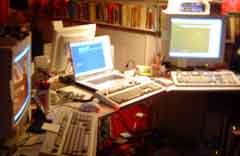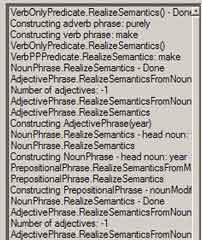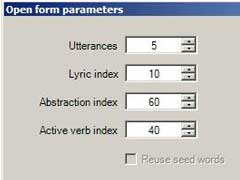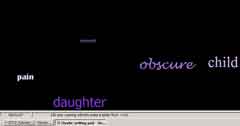This week’s Weekly has my conversation with Jim Carpenter about his poetry machine, featured tonight at Kelly Writer’s House on the Penn campus at 5:30 pm. Here’s the link to the art page and below is the copy with a few pictures.
The Rhyme Machine
Call it an algorithm slam. Machine-made art takes the stage this week at Kelly Writers House as Jim Carpenter and Loss Pequeño Glazier read poems made or influenced by computer software. Carpenter will demonstrate his poetry engine, the Electronic Text Composition (ETC), which I saw in 2004 at Slought Foundation.

Three ETC computers making beautiful poetry together.
Carpenter’s ETC has much in common with the art on display in “Swarm” at the Fabric Workshop and Museum, an exhibit with algorithmically generated art and art made by chance and aggregation. Both the man-machine poetry and the art reflect today’s visual, audio and informational overload and the age-old human need to organize and make something beautiful.
I recently spoke with Carpenter, a Wharton lecturer in systems design and computer programming.
When did you get the idea for a poetry machine?
“Six years ago. I was preparing for my master’s program at Penn and thinking about my thesis. It was required that it be interdisciplinary. I taught English for 12 years in public schools and I was a computer consultant.”

This is the “log” that accompanies the poem on the computer screen and lets you see what commands have been applied to the database
Tell me about the quality of the poems. I know a dozen have been published.
“The quality of the poems is constrained by what I know about poetry and computers. The computer is a tool. The user is the artist. All poems come back to a text editor and can be edited. Sometimes it gets changed. Other times you have something that looks like something somebody might want to read.”
What’s next?
“Speech recognition, so instead of typing in you can speak to the machine. It would be a collaboration between the person and the machine.”
How’s the audience response?
“The reception is varied. Some are almost hostile to the machine. The machine is threatening. Others embrace it without even understanding.”

These are some of the parameters used in the program to set the tone of the poem — how lyric, how long, etc.
Do you think of this as art? There is a visual component.
“Yes.”
Tell me about the software.
“There’s a database, the British National Corpus. It’s words and the software creates words paired together. If you type in ‘farm’ it will find words that go with farm. And grammatical rules decide which words appear in the sentence and determine which words go together in what framework.”
So it’s not random.
“If it’s random words it’s nonsense. Early on I thought you didn’t have to have rules, but I found that nonsense is boring.”
You’re not the first to do this?
“People have been trying to do this for years. Erin Moure. Charles Hartman-from the late ’80s/early ’90s-he laid the groundwork.”

Detail of a screen shot of one of the poems showing various typefaces and sizes of the words
You’ve got audio now and the voice is a woman with an English accent.
“There are four voices: British female, British male, American female, American male. It’s interesting when I have three machines going all at once with three different voices.”
It must be like having ghosts in the house.
“A funny thought. Jack Spicer, a ’50s-era poet, saw the poet as a radio receiver. You wait for the poem to come-you don’t create it. The poem comes from ghosts or from Martians.”
“Constructing Poets: Glazier and Carpenter”
Wed., Feb. 15, 5:30pm. Free. Kelly Writers House, 3805 Locust Walk. 215.573.9748.









